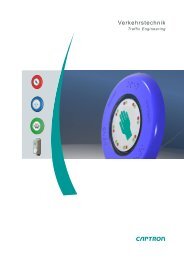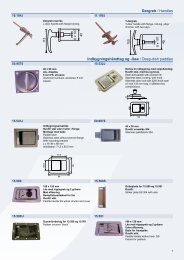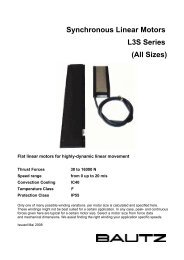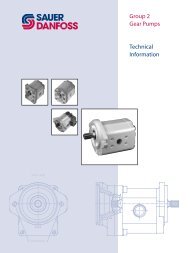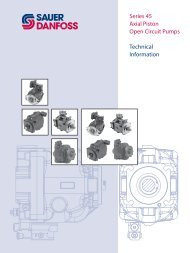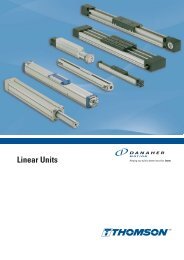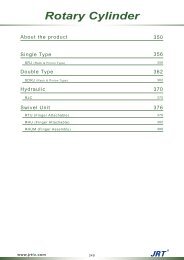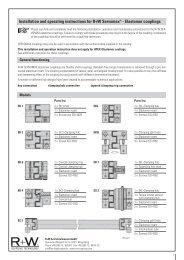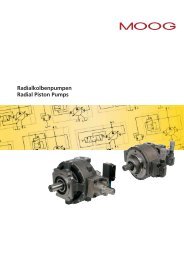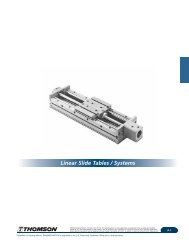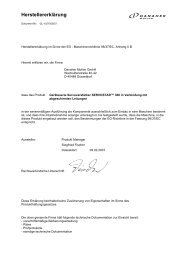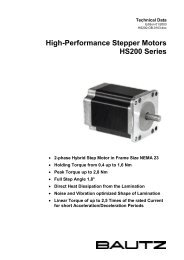Sauer-Danfoss series S90 axial piston pumps
Sauer-Danfoss series S90 axial piston pumps
Sauer-Danfoss series S90 axial piston pumps
- TAGS
- series
- axial
- piston
- pumps
- www.bibus.hu
Create successful ePaper yourself
Turn your PDF publications into a flip-book with our unique Google optimized e-Paper software.
fLuiD anD fiLtRation<br />
CHaRGe PRessuRe<br />
inDePenDent bRakinG<br />
system<br />
ReseRvoiR<br />
Series 90 Axial Piston Pumps<br />
Technical Information<br />
System design parameters<br />
12 520L0603 • Rev FC • August 2008<br />
To prevent premature wear, it is imperative that only clean fluid enter the hydrostatic<br />
transmission circuit. A filter capable of controlling the fluid cleanliness to ISO 4406 class<br />
22/18/13 (SAE J1165) or better under normal operating conditions is recommended.<br />
The filter may be located either on the inlet (suction filtration) or discharge (charge<br />
pressure filtration) side of the charge pump. The selection of a filter depends on<br />
a number of factors including the contaminant ingression rate, the generation of<br />
contaminants in the system, the required fluid cleanliness, and the desired maintenance<br />
interval. Filters are selected to meet the above requirements using rating parameters of<br />
efficiency and capacity.<br />
Filter efficiency may be measured with a Beta ratio ¹ (β X). For simple suction-filtered closed<br />
circuit transmissions and open circuit transmissions with return line filtration,<br />
a filter with a β-ratio within the range of β 35-45 = 75 (β 10 ≥ 2) or better has been found to<br />
be satisfactory. For some open circuit systems, and closed circuits with cylinders being<br />
supplied from the same reservoir, a considerably higher filter efficiency is recommended.<br />
This also applies to systems with gears or clutches using a common reservoir. For these<br />
systems, a charge pressure or return filtration system with a filter β-ratio in the range of<br />
β 15-20 = 75 (β 10 ≥ 10) or better is typically required.<br />
Because each system is unique, only a thorough testing and evaluation program can fully<br />
validate the filtration system. Please see Design Guidelines for Hydraulic Fluid Cleanliness,<br />
520L0467, for more information.<br />
The charge pressure setting listed in the model code is based on the charge flow across<br />
the charge pressure relief valve at fluid temperature of 50 °C [120 °F].<br />
W Warning<br />
unintended vehicle or machine movement hazard.<br />
The loss of hydrostatic drive line power, in any mode of operation (forward, neutral, or<br />
reverse) may cause the system to lose hydrostatic braking capacity. You must provide a<br />
braking system, redundant to the hydrostatic transmission, sufficient to stop and hold<br />
the vehicle or machine in the event of hydrostatic drive power loss.<br />
The reservoir should be designed to accommodate maximum volume changes during<br />
all system operating modes and to promote de-aeration of the fluid as it passes through<br />
the tank.<br />
A suggested minimum total reservoir volume is 5/8 of the maximum charge pump<br />
flow per minute with a minimum fluid volume equal to 1/2 of the maximum charge<br />
pump flow per minute. This allows 30 seconds fluid dwell for removing entrained air at<br />
the maximum return flow. This is usually adequate to allow for a closed reservoir (no<br />
breather) in most applications.<br />
1 Filter βx-ratio is a measure of filter efficiency defined by ISO 4572. It is defined as the ratio of the number of<br />
particles greater than a given diameter (“x” in microns) upstream of the filter to the number of these particles<br />
downstream of the filter.



